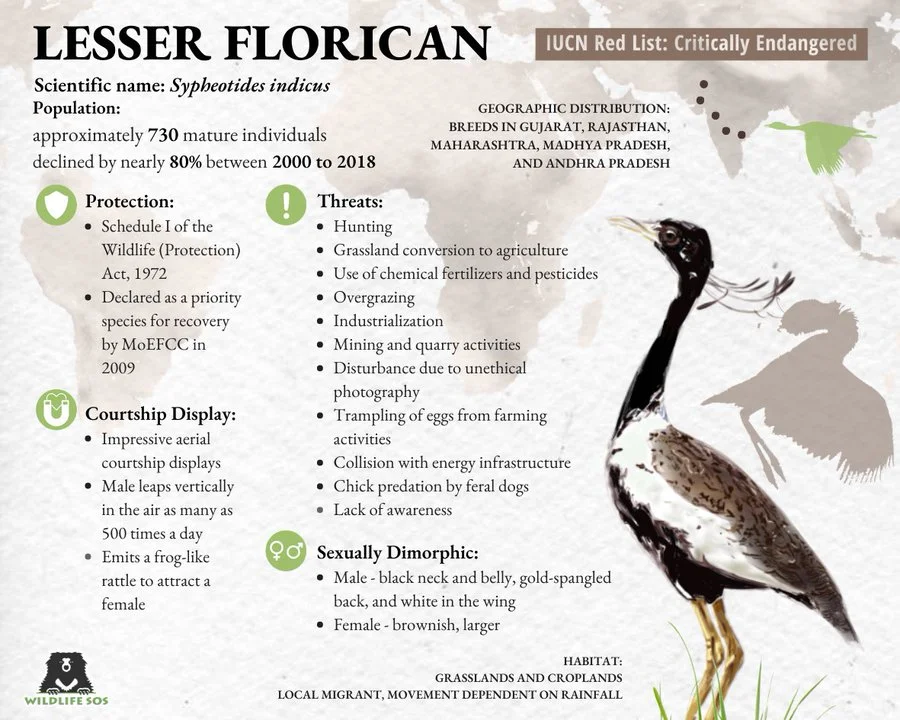Facts for UPSC Mains
Intergenerational Equity & Conservation of Endangered Species
- 13 Nov 2025
- 9 min read
Why in News?
The Supreme Court (SC) of India reviewed the conservation status of the Great Indian Bustard (GIB) and the Lesser Florican, questioned the relevance of Western principles like intergenerational equity for protecting species close to extinction, and stressed the need for an eco-centric approach to biodiversity governance.
What is the Principle of Intergenerational Equity?
- About: It is the idea that each generation has both the right to use and enjoy natural resources and the responsibility to conserve them for future generations.
- It treats the environment as a shared inheritance, not something one generation can exhaust at the cost of the next.
- Recognition in International Law: This principle is embedded in several major international agreements, including the United Nations Framework Convention on Climate Change (UNFCCC), and the Convention on Biological Diversity, the World Heritage Convention.
- It also appears in foundational global declarations like the Stockholm Declaration(1972) and the Rio Declaration(1992), highlighting its long-standing acceptance in environmental governance.
- Role in Biodiversity and Sustainability: The Kunming-Montreal Global Biodiversity Framework reinforces this principle by encouraging active involvement of younger generations in environmental decisions.
SC's Observation on the Principle of Intergenerational Equity
- Anthropocentric Nature of the Principle: The Court noted that intergenerational equity is human-centred, focusing on conserving resources mainly for the benefit of future human generations.
- SC noted that, it treats nature as a resource to pass down, ignoring the intrinsic value of species and ecosystems beyond human use.
- Limited Protection for Endangered Species: The Court observed that the principle offers weak conservation support when a species is already close to extinction.
- This limits its usefulness in biodiversity law, especially for critically endangered species like the GIB and Lesser Florican.
What are the Key Facts About Great Indian Bustards and Lesser Floricans?
Great Indian Bustard
- About: The Great Indian Bustard is a critically endangered grassland bird. It is one of the four bustard species in India, along with the Lesser Florican, Bengal Florican and Macqueen’s Bustard.
- The GIB is omnivorous and highly vulnerable to power line collisions due to its poor frontal vision.
- Distribution and Habitat: Found in India and the eastern regions of Pakistan. It lives in arid and semi-arid grasslands, open landscapes with thorny scrub and tall grasses mixed with cultivation.
- In India it is present mainly in Rajasthan, with smaller populations in Karnataka, Maharashtra, and Madhya Pradesh
- Breeding and Behaviour: Males remain solitary during the breeding season but may form flocks in the non-breeding period.
- Ecological Importance: GIB acts as an indicator species, it reflects the health of grassland ecosystems. Their decline signals degradation of native grasslands.
- Protection Status: IUCN Red List (Critically Endangered).
- CITES (Appendix 1)
- Convention on Migratory Species (CMS) (Appendix I).
- Wildlife (Protection) Act, 1972 (Schedule I).
- There are around 70 Bustards in captivity and 150 in the wild.
- Threats: The species faces severe threats from habitat loss, power line collisions, hunting, and predation by free-ranging dogs.
Lesser Florican
- About: The Lesser Florican is the smallest bird in the bustard family. It has a small body with longish bill and legs.
- Distribution and Habitat: Breeds in Gujarat, Rajasthan, Maharashtra, and Madhya Pradesh.
- They are found in productive lowland grasslands (below 250 m), dry grasslands with scattered scrub, and sometimes in cotton and millet fields.
- It is a rare summer visitor to the Terai region of Nepal.
- Conservation Status: IUCN Red Lis (Critically Endangered)
- Wildlife Protection Act,1972 (Schedule I)
- CITES (Appendix II)
What are SC’s Recommendations for Biodiversity Conservation?
- Shift Toward an Eco-Centric Approach: In T.N. Godavarman Thirumulpad vs Union of India (2012), the SC affirmed an eco-centric approach, stating that the Constitution requires compassion for all living beings and that species have intrinsic value beyond human use.
- The Court urged a shift away from anthropocentric thinking toward an eco-centric philosophy.
- Stronger Protection for Critically Endangered Species: Calls for focused, science-based conservation action for species like the Great Indian Bustard and the Lesser Florican.
- Fair treatment extends to animals : In Animal Welfare Board of India v. Nagaraja (2014), the SC held that Article 21’s guarantee of dignity and fair treatment extends to animals, reinforcing the constitutional duty to protect their well-being.
- The Court urged that environmental and wildlife laws be consistently interpreted to support long-term ecological balance and sustainable conservation.
Conclusion
The Supreme Court stressed that conservation of the dying species needs an eco-centric approach rather than human-centred principles. The Court reaffirmed that safeguarding endangered species is a constitutional and ecological responsibility.
|
Drishti Mains Question: Examine the limitations of intergenerational equity principle for conserving critically endangered species in India. Suggest alternatives with legal and policy measures. |
Frequently Asked Questions (FAQs)
1. What is intergenerational equity?
Intergenerational equity holds that each generation may use natural resources but must conserve them for future generations.
2. Why did the Supreme Court find intergenerational equity inadequate for endangered species?
The Court said the doctrine is essentially anthropocentric (focusing on human benefit across generations) and offers limited protection when species require immediate, species-specific, eco-centric interventions.
3. What practical measures did the Supreme Court recommend for bustard and florican conservation?
The Court urged an eco-centric policy focus: stronger habitat protection, science-based recovery programmes (including captive breeding), infrastructure mitigation (undergrounding/rerouting power lines), and timely implementation of conservation directives.
UPSC Civil Services Examination, Previous Year Questions (PYQs)
Prelims
Q. Which one of the following groups of animals belongs to the category of endangered species? (2012)
(a) Great Indian Bustard, Musk Deer, Red Panda and Asiatic Wild Ass
(b) Kashmir Stag, Cheetal, Blue Bull and Great Indian Bustard
(c) Snow Leopard, Swamp Deer, Rhesus Monkey and Saras (Crane)
(d) Lion-tailed Macaque, Blue Bull, Hanuman Langur and Cheetal
Ans: (a)
Q. With reference to India’s Desert National Park, which of the following statements are correct? (2020)
- It is spread over two districts.
- There is no human habitation inside the Park.
- It is one of the natural habitats of Great Indian Bustard.
Select the correct answer using the code given below:
(a) 1 and 2 only
(b) 2 and 3 only
(c) 1 and 3 only
(d) 1, 2 and 3
Ans: (c)
Mains
Q. How does biodiversity vary in India? How is the Biological Diversity Act,2002 helpful in the conservation of flora and fauna? (2018)








